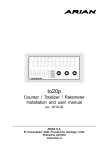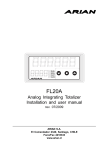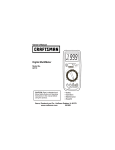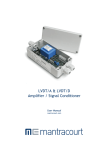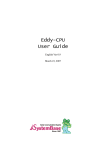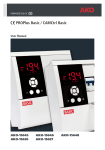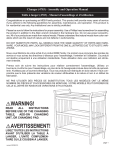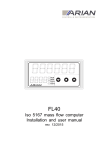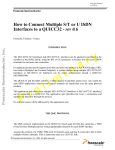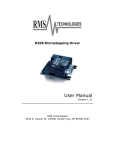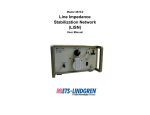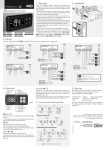Download User Manual - Arian S.A.
Transcript
NEG RUN OUT1 OUT2 ARIAN RUN MAN OUT1 OUT2 id20-bas / id20-vac / id20-tac Panel Meters Installation and User Manual rev. 2010/02 ARIAN S.A. El Comendador 2340, Providencia, Santiago, CHILE Phone/Fax 56-2-4218333 www.arian.cl PRELIMINARY INFORMATION This document haves copyright reserved, C Arian INC. Referred trademarks are of property of its respective owners. ARIAN is registered by Arian S.A. Technical help If you find problems with the instrument, check its configuration to be coherent with the application. If still it persists the problem, help can obtain by the following media: Arian S.A. El Comendador 2340, Providencia Santiago, Chile [email protected] Phone/fax 56-2-4218333 www.arian.cl Revision history rev. 12/02 Configuration munu is modified for new thermocouples. New modbus RTU comunications menu rev. 12/04 Descaded version id20-iac and introduced versión id20-vac. Added one display 3 1/2 digit versions. Offset adjust added for id20-bas rev. 02/06 New input voltage scales for id20-vac. rev. 2007/08 Id20-tac Input configuration menu changes and period measure. rev. 2010/02 Magnetic pick up input for Id20-tac. GENERAL DESCRIPTION ......................................................................... 4 PART CODE .................................................................................................................... 5 TECHNICAL SPECIFICATIONS ..................................................................................... 6 INSTALLATION ........................................................................................... 7 id20-bas Inputs................................................................................................................ 7 id20-vac Inputs ................................................................................................................ 8 id20-tac Inputs................................................................................................................. 9 Alarm outputs ................................................................................................................ 10 Analog outputs (optional) .............................................................................................. 10 RS485 serial communications. (optional) ..................................................................... 10 Power supply ................................................................................................................. 10 Panel assembly ............................................................................................................. 10 CONFIGURATION FROM PC (RPS) ........................................................ 11 CONFIGURATION .................................................................................... 12 General Configuration menu ( O P E r ). ....................................................................... 13 ID20-BAS Input configuration........................................................................................ 15 ID20-VAC Input configuration ........................................................................................ 17 ID20-TAC input configuration ........................................................................................ 19 Alarms configuration. .................................................................................................... 21 Analog output configuration 4-20 mA. or 0-10V ............................................................ 23 Serial RS485 communications configuration. ............................................................... 25 OPERATION (2 display version) ............................................................. 26 Input sensor failure. ...................................................................................................... 26 Activated Alarm. ............................................................................................................ 26 Special reset functions. ................................................................................................. 26 Access to the Parameters menu. .................................................................................. 26 Sub-menu r E A d , examine parameter values. .......................................................... 27 Sub-menu S P n t , modify alarms Set Points. .............................................................. 28 Sub-menu F u n c , reset maximum, minimum, disabling outputs. ................................ 31 OPERATION (One 3 1/2 digits display version). .................................... 32 Minus sign. .................................................................................................................... 32 Input sensor failure. ...................................................................................................... 32 Activated Alarm. ............................................................................................................ 32 APPENDIX A ............................................................................................ 33 How to enter a number in floating point format from frontal buttons . ........................... 33 GENERAL DESCRIPTION The id20 industrial panel meters is composed by 3 models (id20-bas, idvac, id20-vac) that covers a broad range of inputs. Each model is presented on versions of one (3 1/2 digits) or two (4 digit) displays and several optionals that help to configure the required instrument. As standard all instruments comes with 2 output relays and a complete programmable alarm system. Inputs The id20-bas is the basic version of the instrument, includes thermocouples, Pt100, 4...20mA, 0...10V and 0...50mV inputs. This is the most common instrument. The id20-vac is a AC true RMS voltimeter and amperimeter (and bipolar DC also) with several input scales. May be used with shunts, current transformers or direct measurement of AC/DC voltages up to 600V. The id20-tac is a tachometer or rate meter, only admits pulse inputs e.g.. NPN, PNP and Mechanical Switch. Frequency measurement is done counting the input pulses and simultaneously measuring the time among them. This method allows precise and quick readings especially at low frequencies where the measurement is obtained mainly from the period among pulses. Also simplifies the input programming, not having to define “time windows” in which the count is carried out. Alarms Possesses two output relays, each one corresponds to 2 programmable alarms (high and low). Alarms can be absolute or relative to a general set point. Includes alarm latch and inhibit when changing set points ("standby"). Readings Versions of one and two displays are almost identical, except that one display instruments does not have frontal push bottoms so only can be programmed with help of a PC and RPS software. Also the maximum reading is limited to +-1999 on one displayversions. Registers the measured variable maximum and minimum readings. Display B Display A ARIAN STR. STP RUN MAN OUT1 RST. OUT2 NEGATIVE RUN OUT1 OUT2 ARIAN User Manual id20-bas, id20-vac, id20-tac, rev.2010/02, www.arian.cl 4 PART CODE Defining a part number must be done selecting the following alternatives. Last 2 ones (-420A, -420L), -RS85 are optional that must not be included if no required. ID20 -BAS -TAC -VAC -AC -DC -2D4 -1D3 -420A -420L -RS485 -BAS :basic version, for thermocouples, pt100, 0-10V, 4-20ma, ... -TAC :rate meter -VAC :amperimeter, voltimeter DC and AC true RMS. -AC :power supply 85...260 Vac, 6 W, 45...65 Hz. -DC :power supply 18....60 Vdc, 6 W -2D4 :two displays, 4 digits each 14mm and 9mm heigth with frontal push buttoms -1D3 :one display, 3 1/2 digits, 25mm heigth without frontal push buttoms OPTIONAL OUTPUT -420L :4..20ma pasive loop -420A :4..20ma active, includes also 0..10Vdc OPTIONAL -RS485 :modbus RTU serial communications For example: ID20-BAS-AC-2D4 basic meter, AC power supply , 2 displays, without any optional output. ID20-TAC-DC-1D3-RS485 Rate meter, DC power supply, 1 display and modbus RTU serial communications. User Manual id20-bas, id20-vac, id20-tac, rev.2010/02, www.arian.cl 5 TECHNICAL SPECIFICATIONS INPUTS id20-bas: id20-vac: id20-tac: Resolution 16 bit a/d, CMRR 100 dB min., 400 VAC. Min. Input break protection TC with preset action. Thermocouples (100 ohm max.): Centigrade Degrees or Fahrenheit J (-60, 760) °C k (-100, 1372) °C. T (-86, 400) °C. R -1 mV, 1767 °C. S -1 mV, 1764 °C. B -1 mV, 1815 °C. N (-139, 1298) °C. E (-176, 750) °C. Platinel (0, 1394) °C. C (0, 2314) °C. D (0, 2314) °C. G (0, 2313) °C. PT100 ( -136, 450 ) °C DIN43760, alpha=0.0385 4...20 mA, 0...20 mA, 0...5 V, 1..5 V, 0..10 V, 0..50 mV, scalable for engineering units. Resolution: 18 bit a/d, CMRR 100 dB min., 400 VAC. Min. DC: Bipolar simetrical input (positive/negative voltages/ currents) AC: True RMS. Scales: +/-5 Ampers, +/-60mV, +/-16V, +/-100V, +/-600V Pulse inputs: NPN, PNP, Mechanical switch, TTL, High voltage (500 V) and magnetic pick up (200mVAC min.). Provides feeding for input sensor, +5, -7.5 Vdc, 30mA max. Frequency range 0.01Hz ... 50KHz READINGS: Versions: Allows engineering units with decimal places. Register max/min readings. -2 display 4 digits (14mm , 9mm ) , range -999...9999 -1 display 3 1/2 digits (26mm ), range -1999... 1999 (no push bottoms) ALARMS: 2 independent alarm outputs, each one with high and/or low alarm, with absolute or relative set point. Programable alarm latch and "standby" that inhibits alarms when modifying set points). OUTPUTS Relays, 2 outputs for alarms 250VAC/ 3A., normally open or normally close by software. All of them are opto isolated up to 5kV. -420L 4.. 20 mA, loop powerd, Vdrop 4.5V max. -420A 4.. 20ma/0-10V Active loop. -RS485 modbus RTU serial communications Optionals: POWER SUPPLY: Current mode switching power supply. 85...260 Vac, 6 W, 45...65 Hz. 20...60 VDC, 6 W, (optional) CONSTRUCTION: Aluminum and y Polycarbonate; Total Dimension: Panel cut: Weight: Operation temperature: IP65 DIN 1/8; 96 x 48 x 135 mm. 92 x 45 mm. 300 grams. 0 ... 50 °C. User Manual id20-bas, id20-vac, id20-tac, rev.2010/02, www.arian.cl 6 INSTALLATION id20-bas Inputs Depending on the input or sensor type, connections in the terminals should be done as indicated in the drawing. Terminal 3 is connected to the instrument internal ground and can used for the connection of external shield of some thermocouples or sensors. It is important that the cables that bring the sensor signal be apart from cables connected to the output relays since this normally are inductive loaded. When deactivated this relays can generate high voltage spikes that can cross the cable insulator and disturb, even damage the input circuit. id20-bas Conexiones eléctricas RS-485 B A V+ Gnd 90..260Vac ENTRADA P. SUP PT100 0..20mA, 4..20mA 0..10V, 0..5V, 0..50mV ALIMENTACION Termocuplas OUT 1 RELE ANALOG OUT Gnd -I +V +I OUT 2 RELE 2A AC 2A AC FID2021 User Manual id20-bas, id20-vac, id20-tac, rev.2010/02, www.arian.cl 7 id20-vac Inputs Terminal #3 (Gnd) is the common ground for all voltage and current inputs. Terminal #2 is used for 2V and 60mV scales. The scale must also configured, selecting it by a internal pin (see input configuration chapter). All of the inputs are for AC and DC. The maximum allowed voltages and currents are indicated on the terminal screws. For currents that exceed 5 Ampers AC, you must use a current transformer (eg. 100A/5A). For example if you have a 140V input , you must use the 200V input on terminals #11 and #3. Later you reescale readings on the configuration menu. Current Transformer 6V 20V 60V 200V 2V 60mV Gnd 600V 5 Amp id20-vac Electrical conections 90..260Vac P. SUP RS-485 B A OUT 1 RELE ANALOG OUT Gnd +V -I +I OUT 2 RELE 2A 2A AC AC FID2022B User Manual id20-bas, id20-vac, id20-tac, rev.2010/02, www.arian.cl 8 id20-tac Inputs The id20-tac tachometer admits several different input pulse types with a maximum frequency of 50khz and minimum of 0.01 Hz. There are some internal jumpers to be configured according to the input type (see input configuration menu) Open collector input switchs or any device Feeding the sensor is 7.5v limited to 35mA (terminals #11, #2, #1) used with inductive proximity with NPN, PNP open collector output. done by terminals #1 and#2 that supply +5v and max. High voltage input (terminals #10 , #3) for pulses on the range 15V...500V. Can be AC pulse with cero cross. TTL and low voltages (terminals #11, #3) need pulses higher than 3V and lower than 50V. Voltage must go down to 1V to be recognized. Magnetic pick-up (terminals #11, #3) needs a signal higher than 200mV AC. Mechanical switch (terminals #11, #2) used with relays or pushbuttoms. Conexiones Eléctricas id20-tac + V _ Signal HV S1 RS-485 B A ANALOG OUT +5 -7.5 Gnd 90..260Vac Alimentación P. SUP OUT 1 RELE OUT 2 RELE Gnd -I +V +I S1 (11) Gnd ( 3) TTL , Pick Up Magnetico + V _ HV (10) Gnd ( 3) Alto Voltage S1 (11) -7.5V ( 2) Switch Mecánico Cafe +5V ( 1) Negro S1 (11) Azul -7.5V ( 2) Switch Inductivo NPN o PNP. User Manual id20-bas, id20-vac, id20-tac, rev.2010/02, www.arian.cl FID2019b 9 Alarm outputs Relays are the standard option for alarm outputs. As seen in the figure, relay for alarm 1 (OUT 1) goes to terminals 6 and 7. The one for alarm 2 (OUT 2) to terminals 8 and 9, both are normally open outputs (NO). Care must be taken on not exceeding the maximum relay current (3 Amp.), since they would be damaged quickly. Is recommended to use fuses in series with the relays to protect them. Never use directly the internal relay with the load. Always a external contactor should be used to drive the final load. Analog outputs (optional) For isolating and retransmitting the measured variable to a PLC or another instrument. If this options are installed please refer to "analog output configuration" chapter for details. RS485 serial communications. (optional) For communicating with PC or PLC using modbus RTU software protocol. This is an isolated out that drives standard RS485 5Volts signals. If this options are installed please refer to "RS485 communications configuration" chapter for details. Power supply The instrument power supply is designed to operate with any voltage between 90 and 260 volts without need of adjustment. (20VDC to 60VDC for the DC power supply option). Once start up will continue operating unless the network fall under 50 VAC. The instrument possesses an internal 0.5Amp fuse that should be replaced with a similar one. Panel assembly Designed for panel assembly in a 92 x 45 mm. cut (Format DIN 1/8). using clamps included with the instrument. User Manual id20-bas, id20-vac, id20-tac, rev.2010/02, www.arian.cl 10 CONFIGURATION FROM PC (RPS) Two displays versions may be programmed by frontal push bottoms while one display versions does not have push bottoms, so only can be programmed from a PC compatible computer. The following is needed: - The PC compatible computer with vga monitor. - RPS software (download latest version from www.arian.cl) - Isolating interface cable. Part# RPS-C While using the RPS system the configurating menus are the same described in following chapter for frontal push bottoms programming. With de-energized intrument, the interface cable must be conected by one side to the internal conector as shown in the picture. The other side of the cable goes to the PC serial RS232 port (DB9). Once done the conection the instrument must be energized and RPS software executed in the PC. The interface cable does optical isolation between PC and instrument. Concluded the programming you must de-energized the device and then plug off the interface cable. User Manual id20-bas, id20-vac, id20-tac, rev.2010/02, www.arian.cl 11 CONFIGURATION The id20 panel meters admit different operation forms that should be set in the configuration menu. Normally the instrument is shipped configured according to requested specifications. For modifying this configuration the instructions are now presented. To enter the configuration menu press the center button [•] and without releasing it, press and release one time the "right or upper" button [^] . Doing that, the message "KEY" will appear in the upper display. At this moment the instrument asks for a access key. Now the number 2736 should be introduced in the lower display using the "left or lowering" and "right or upper" button. Once the number 2736 is in the lower display, press the button [•] to enter. Now in the upper display appears the message M E n u. With the lateral buttons select one of the 5 menus and to press center button [•] to enter. To quit, select the option "SALi" or wait 16 seconds without pressing any button. M E n u O P E r. General menu, configuring displays, operation modes and other options. I n P t. analog input configuration. A L - 1 alarm 1 configuration. A L - 2 alarm 2 configuration. 4 - 20. analog output, 0...10V, 4...20mA (if it is available) r 4 8 5 rs485 serial communications. S A L i Returns to operation mode. Once entering one of the menus, if no button is press in 16 seconds, the devices returns automatically to operation mode. At the end of each menu, always is asked if is desired to program the new data and then to quit or continue configuring. These questions are presented as: P r o g is asked if is desired to program or not the instrument with the introduced values. Selecting "No", values recently placed will be erased and original values will not change. N o Do not program new values. S i Set in EEPROM new values. S A L i Select “Si” starting of N o S i for quit (exit) the menu and “N o” for returning back to the the actual configuration menu. Continue in this menu. Quit or exit the menu. User Manual id20-bas, id20-vac, id20-tac, rev.2010/02, www.arian.cl 12 General Configuration menu ( O P E r ). d i s. b "display b" is the upper one, on this point is defined the variable that will be indicated continuously on the upper display. I n P t I. n. P. t. P.d i. b Indicates temperature or process value PV. Temperature or PV with a decimal point. Places a fixed decimal point in the "display b" to facilitate the viewing engineering units. -. -. - -. - - Without decimal point. NOTE The following programmable parameters are only valid for id20 versions with pushbuttoms and 2 displays (A and B). For one display devices only B display is present and are no push buttoms. d i s. A "display A“ is the lower one. o F F I n P t M A C S M i n i S P. r E S P. 1. H S P. 1. L S P. 2. H S P. 2. L turns off the display. Indicates temperature or process value PV. . maximum of the PV. minimum of the PV. Common Set Point for relative set point alarms. Set Point or alarm 1 upper activation point (High). Set Point or alarm 1 lower activation point (Low). Set Point or alarm 2 upper activation point (High). Set Point or alarm 2 lower activation point (Low). P.d i. A Places a fixed decimal point in the "display A" to facilitate the viewing engineering units. The options are the same described for "display b". b o t . L Special function configuration for the button [v] on the front panel (the lower or left one). o F F r S t . N r S t . A d i . A L there is no function assigned. Reset registered maximum and minimum of PV. Reset latched alarms. Disable/restore momentarily the alarm relay outpus. While disabled the alarms, the "RUN" led on front panel blinks quickly. User Manual id20-bas, id20-vac, id20-tac, rev.2010/02, www.arian.cl 13 b o t . H Special function configuration for the button [^] on the front panel (the upper or rigth one). The options are the same of the previous one. S P . L c = No, Si Set points Lock. It should be set "Si", to avoid the operator to modify the alarm Set Points. It blocks the access to menu "S P n t" described in the operation chapter. F u . L c = No, Si Special functions lock. It should be set "Si", to restrict operator access to "F u n c" menu of special functions (eg. reset maximum, minimum, alarms, etc) as described in operation chapter. P r o g = No, Si Set "Si" for programming new data. Otherwise data will be lost when quitting this menu. S A L i = No, Si Set “Si” for quitting this menu. Otherwise return back to its starting point. User Manual id20-bas, id20-vac, id20-tac, rev.2010/02, www.arian.cl 14 ID20-BAS Input configuration I n t Y Input type. t c P100 PrcS thermocouple input RTD type Pt100 DIN43760 (-136, 450) C. processes input 4-20mA, 0-10Volts and others. Depending on selected input type, internal jumpers must be placed as the figure describes. Selecting input as thermocouple or pt100, the instrument will pass to ask for temperature units. While, if selected process variable input (0-20mA,420mA,..,0-50 millivolts), the instrument will ask for the limits or input calibration. t Y P E Thermocouple type. If select thermocouple input, now is set the type and temperature units. Tipo RANGO t c J J (-60, 760) C. t c k k (-100, 1372) C. t c t T (-86, 400) C. t c r R -1 mV, 1767 C. t c s S -1 mV, 1764 C. t c b B -1 mV, 1815 C. t c n N (-139, 1298) C. t c E E (-176, 750) C. t c PL Platinel (0, 1394) C. t c C C (0, 2314) C. t c d D (0, 2314) C. t c G G (0, 2313) C. U n i t = °C. , °F. Select Centigrade or Fahrenheit degrees. O F S t = -19.9° ..., 19.9° Input sensor off set adjustmen. The programmed number will be added to measured temperature in order to compensate known errors. Normally must be set in cero. Configuración de Pines de Entrada id20-bas Termocuplas, Pt-100, 0-50mV 4-20mA, 0-20mA 0-10V, 0-5V, 1-5V fid20_16 User Manual id20-bas, id20-vac, id20-tac, rev.2010/02, www.arian.cl 15 t Y P E Processes input type. Type 0 - 20. 0- 20 milliamperes. 4 - 20. 4- 20 milliamperes. 0 - 5 v. 0- 5 volts. 1 - 5 v. 1- 5 volts. 0 - 10. 0- 10 volts. 0 - 50 0- 50 millivolts. Range -24 mA, 24 mA. 2 mA, 24 mA. -2 V, +12 V -2 V, +12 V -2 V, +12 V -10 mV, +60 mV L. i n F = -999... 9999 Introduce reading value for input at the lower limit of selected input type. For example the input is 4-20mA originated in a temperature transducer that delivers 4 mA at 0 degrees and 20 mA at 1000 degrees. In this case is being asked for the reading at 4 mA, that is LinF = 0. L. S u P = -999... 9999 Introduce reading value for input at the higher limit for selected input type. For the same previous example, it is asking for reading at 20mA input, that is LSuP = 1000. F I L t = 1 ... 16 Corresponds to a time constant for filtering or conditioning noisy inputs. Internally the instrument carries out a first order low pass filter calculation with time constant "FILt". Can be set between 1 and 16 seconds. Better you should leave this value set to 1 second, increasing it only if its required by having noisy readings. P r o g = No, Si Set "Si" for programming new data. Otherwise data will be lost when quitting this menu. S A L i = No, Si Set “Si” for quitting this menu. Otherwise return back to its starting point. User Manual id20-bas, id20-vac, id20-tac, rev.2010/02, www.arian.cl 16 ID20-VAC Input configuration On configuring the input of the ID20-VAC, you must take care of the following 3 points: -The signal must arrive to the terminal indicated on page 8 figure. For example, signals up to 100V must be conected to terminales #11, #14(Gnd) - Removing dive top cover gives you access to a pin on the back part. This pin may have 3 different positions acordinng the figure on this page. - Finally you must specify by software on the following menu the type of input you are applying and reading scales. Configuración de Pines de Entrada id20-vac 60 mV 5 Ampers 2V, 6V, 20V, 60V, 200 V, 600 V fid20_17 I n t Y Input type. Input signal must be contained in one of the following ranges. 5. A. Current, up to 5 Ampers max (AC or DC). 6 0.mV. Voltage, range -60mV to +60mV 2.V. -2V to +2V 6.V. -6V to +6V 2 0.V. -20V to +20V 6 0.V. -60V to +60V 2 0 0.V. -200V to +200V 6 0 0.V. -600V to +600V A c. d c. = Input type for Volts or current A c. True RMS AC measurement d c. DC L c. L o = -999... 9999 Set the reading that correspond to the lower limit of the input. L c. H i = -999... 9999 Set the reading that correspond to the higher limit of input. User Manual id20-bas, id20-vac, id20-tac, rev.2010/02, www.arian.cl 17 V o. L o = -999... 9999 Input voltage (or current) lower limit Reading programmed as Lc.Lo will correspond to this voltage. V o. H i = -999... 9999 Input voltage (or current)higher limit Reading programmed as Lc.Hi will correspond to this voltage. F I L t = 1 ... 16 Corresponds to a time constant for filtering or conditioning noisy inputs. Internally the instrument carries out a first order low pass filter calculation with time constant "FILt". Can be set between 1 and 16 seconds. Better you should leave this value set to 1 second, increasing it only if its required by having noisy readings. P r o g = No, Si Set "Si" for programming new data. Otherwise data will be lost when quitting this menu. S A L i = No, Si Set “Si” for quitting this menu. Otherwise return back to its starting point. Example 1 You have a signal coming from a 250/5 current ratio current transformer. Set the following parameters: I n t Y A c. d c. L c. L o L c. H i V o. L o V o. H i = = = = = = 5.A. A c. 0 250 0 5 Another example A field sensor output is dc voltage with the range -2V... +10V corresponding to a process value PV = 0... 100% on a linear ration. I n t Y A c. d c. L c. L o L c. H i V o. L o V o. H i = = = = = = 1 6 V. d c. 0 100 -2 10 User Manual id20-bas, id20-vac, id20-tac, rev.2010/02, www.arian.cl 18 ID20-TAC input configuration The id20-tac tachometer makes frequency measurement by counting input pulses and simultaneously measuring the period elapsed among them. This method permits to obtain precise and quick readings especially for low frequencies where the measurement is obtained mainly of the period among pulses. At the same time simplifies input programming not having to define "time windows" in which count is carried out. For input calibration is required to set the instrument with the desired reading Lx corresponding to a Fx frequency in Hz input pulses. Then the reading L of the instrument with F (Hz) input pulses is obtained multiplying by a constant number [k.rat] L = [k.rat] * F If the instrument is used to measure period, the reading is obtained dividing by F L = [k.rat] / F The number [k.rat] must be calculated in order to obtain the desired units for the reading L. Example 1, rate meter For example in certain machine is desired to measure the turns by minute (RPM) of an axe with 7 pulse by turn. Also you need the rate with 2 decimals of resolution. If the axe is working at 1 RPM, then the reading considering the 2 decimals resolution must be Lx= 100 . Later you will set the decimal point to look as 1.00. At 1 RPM the sensor sends 7 pulses by minute then Lx = 100 Fx = 7 / 1minute = 7 / (60seg) = 0.11666666 Hz. Lx = [k.rat] * Fx 100 = [k.rat] * 0.116666Hz k.rAt = 100 / 0.11666666 = 857.1428571 id20-tac Configuración de Pines NPN PNP TTL Switch Mecanico Alto Voltage 200 mV Mag. Pick Up fid20_15b User Manual id20-bas, id20-vac, id20-tac, rev.2010/02, www.arian.cl 19 The result must be in floating point format. In Appendix A is described how to introduce floating point number from the frontal push buttons. If you are using the RPS for configurating from a PC, then you don't need to look appendix A. Example 2, time or period measurement The axe of the example 1 is moving a conveyor band that carries canned food to a continuous baking oven. The oven is 5 meters long and each turn of the axe moves 0.75 meters the conveyor. You need to display the baking time of the cans in minutes with 1 decimal resolution. Given that the sensor brings 7 pulses by turn and each turn moves 0.75m, then on 5 meters there are Nx pulses Nx = 5 / 0.75 * 7 = 46.666 pulses Suppose that the motor speed is such that takes 1 minute for a can to move 5 meters. In this case the reading must be Lx = 10 and the frecuency at the instrument input Fx is Fx = Nx / 1 minute = 46.666 / 60sec = 0.77777 Hz Then Lx = [k.rat] / Fx 10 = [k.rat] / 0.77777 [k.rat] = 7.77777 k. r A t t A u = floating point Proportional constant between frequency input in Hz an the rate reading. = Off, On Instrument operation mode Off ratemeter, On time or period meter, L = [k.rat] * F L = [k.rat] / F F I L t = 1 ... 16 Corresponds to a time constant for filtering or conditioning noisy inputs. Internally the instrument carries out a first order low pass filter calculation with time constant "FILt". Can be set between 1 and 16 seconds. Better you should leave this value set to 1 second, increasing it only if its required by having noisy readings. P r o g = No, Si Set "Si" for programming new data. Otherwise data will be lost when quitting this menu. S A L i = No, Si Set “Si” for quitting this menu. Otherwise return back to its starting point. User Manual id20-bas, id20-vac, id20-tac, rev.2010/02, www.arian.cl 20 Alarms configuration. The id20 possesses 2 independent alarms (alarm-1 and alar-2) each one associated to a output relay (relay-1 and relay-2) Each one of the alarms (alarm-1 and alar-2) haves 2 Set Points, high and low. The alarm will activate when the input passes one of these limit. Once the alarm condition is set, the upper display will operate intermittently indicating that this condition exists. Both Set Points (high and low) for each alarm possess programmable hysteresis and can be defined as absolute value or relative (displacement) to a common Set Point. Now is described the configuration for alarm-1. Configuration of the alarm2 is similar. H i g h High set point for alarm-1. The parameters menu generated for each alarm type are described in the operation chapter. o F F d o n F o n F h L o u Disabled. Dual on/off type high alarm. The alarm activates when input is higher than a value defined by general Set Point "SP. rE" plus a displacement programed in the parameters menu. On/off with histeresis high alarm. The alarm activates when input is higher than a value programed in the parameters menu. Low set point for alarm-1. o F F d o n F o n F h Disabled. Dual on/off type high alarm. The alarm activates when input is lower than a value defined by general Set Point "SP. rE" minus a displacement programed in the parameters menu. On/off with histeresis high alarm. The alarm activates when input is lower than a value programed in the parameters menu. I n . E r Input error. Enable alarm-1 activation when occurs a problem with input (eg. thermocouple break). No disable Si. enable L t c h Enable Latch alarm. If enabled, the alarm condition output will be maintained although the condition that generated it disappears. Operator must reset the latched alarm from the front panel. No disable Si. enable User Manual id20-bas, id20-vac, id20-tac, rev.2010/02, www.arian.cl 21 S t b Y The "standby" function inhibits alarm activation when the operator changes the Set Point or the instrument is powered up. If alarm condition is given in that situation, the activation of the alarm-1 is inhibited until the condition that generates the alarm disappears. After the condition that generates the alarm disappears (eg. the temperature changes so is within the new Set Points) then the alarm is ready to be activated by normal operation. No disable Si. enable r E L E Is specified if the relay-1 will work normally open or normally closed. This relay is active when alarm-1 condition exists. d i r Relay works direct , normally open. i n v Works inverted or normally closed. P r o g = No, Si Set "Si" for programming new data. Otherwise data will be lost when quitting this menu. S A L i = No, Si Set “Si” for quitting this menu. Otherwise return back to its starting point. User Manual id20-bas, id20-vac, id20-tac, rev.2010/02, www.arian.cl 22 Analog output configuration 4-20 mA. or 0-10V This output is optional although the configuration menu is in all instruments, hardware (the optional output board) could not be installed. There are 2 analog output types, both optically isolated. Option -420LP, is 4-20ma loop Powered that requires a voltage source in series with the loop. Its typical use is conditioning and isolating process variable for other instruments as eg. PLC or DCS. Option -420AC, is 0-20mA, 4-20mA or 0-10V, active output. Its used to send the selected variable to instruments whose input should be active (powered) such as 0-10v or a 4-20ma loop powered valve. Exists an internal jumper that must be placed depending on current or voltage output (see figure in the following page) The questions in the menu vary slightly according to board type installed. Option -420LP 4 - 20 o F F o n Option -420AC t Y P E o 0 4 0 F F - 2 0 - 2 0 - 1 0 Disable output. enabled. Disabled. 0 to 20 mA. 4 to 20 mA. 0 to 10 Volts. V A r b Asks by the variable that will be transmitted. See in the following page the table for the possible analog output variables. E. i n F = -999... 9999 Introduce the value of the selected output variable for which the output will deliver 4 mA. (or 0 Volts). For example if output for input temperature was selected, when “E. i n F” = 0, the output will be 4 mA for zero degrees temperature. For lower temperatures the output will descended down to 3.5 mA. aprox. E. S u P = -999... 9999 Introduce the value of selected output variable for which the output will deliver 20 mA. (or 10volts). For the same example, place “E. S u P” = 1000, then the output will be 20 mA when temperature is 1000. For higher temperatures the output will rise up to 20.5mA. C ALi This refers to output board calibration, is reserved for manufacturer use. P r o g = No, Si Set “Si” for programming new data. Otherwise data will be lost when quitting this menu. S A L i = No, Si Set “Si” for quitting this menu. Otherwise return back to its starting point. User Manual id20-bas, id20-vac, id20-tac, rev.2010/02, www.arian.cl 23 + - Option -420AC Salidas 4..20mA y 0..10V Activas 4...20mA and 0...10Volts active output + 4.5V min. + ANALOG OUT Gnd +V -I +I Opcion -420LP Salida 4..20mA pasiva alimentada por Lazo Loop powerd 4...20mA output. 0...10V Para la salida activa, opcion -420AC se debe colocar el PIN en una de las dos posiciones según sea la salida de corriente o voltaje 4..20mA RS-485 B A PLC For active output option -420AC, internal jumper must be set. 420OUT_00 Analog output selectable variables. I n P t S P. r E M A C S M i n i Process General Process Process variable ( input ). Set Point. variable maximum. variable minimum. User Manual id20-bas, id20-vac, id20-tac, rev.2010/02, www.arian.cl 24 Serial RS485 communications configuration. Serial rs485 communications are optional, although the configuration menu is in all the instruments, hardware for its operation could not be installed. The command description for the communications protocol is available as file in internet (www.arian.cl) and includes tag listing with its properties and scales. Characteristics : - RS485 physical protocol with optically isolated interface. - start bit, 8 data bits, parity bit = 0, stop bit - communication protocol, Modbus RTU ,functions 03, 06, 10 The questions in the configuration menu are the following. n o d E o F F , oN Enable or disable communications. b A u d 300, 600, 1200, 2400, 3600, 4800, 9600, 19.2k Communication speed. n. S c L = 1...247 Slave number. P r o g = No, Si Set “Si” for programming new data. Otherwise data will be lost when quitting this menu. S A L i = No, Si Set “Si” for quitting this menu. Otherwise return back to its starting point. User Manual id20-bas, id20-vac, id20-tac, rev.2010/02, www.arian.cl 25 OPERATION (2 display version) The location of the front panel buttons can be seen in the figure. The central button [•] is the main one, is used for selecting and to entering the parameters. The lateral buttons are used to increase or decrease the selected parameter. The LEDs "OUT 1" and " OUT 2" reflect the state (activated or desactivated) alarm relays. Input sensor failure. In case an error or failure in the input exists (for example broken thermocouple), the display lower will show in intermittent form the message " In Er". The instrument will wait for 10 consecutive good readings in the input before returning to the normal operation mode. Activated Alarm. When one alarm becomes active (AL-1 or AL-2) the upper display that normally shows the temperature or Process Value, blinks in intermittent form ( 2 seconds) for advising the operator that a alarm condition has occurred. Special reset functions. If these functions are enabled from the general configuration menu, is possible to reset the maximums, minimum, latched alarms or disable momentarily the relay outputs by pressing one of the front panel buttons [^] or [v]. Access to the Parameters menu. For entering to the parameters menu press the center button [•], immediately one of 3 submenus should be selected by means of the lateral buttons and finally press again the center button [•] to enter the selected sub-menu. r E A d Examine parameters values. S P n t Modifies alarm Set Points. F u n c Reset functions and outputs disable. Following the content of each sub-menu is described. Display B Display A RUN MAN OUT1 OUT2 FIG-H2X4 User Manual id20-bas, id20-vac, id20-tac, rev.2010/02, www.arian.cl 26 Sub-menu r E A d , examine parameter values. This menu only permits to examine (not to modify) the values of some internal parameters. I n P t Shows the input process value PV or measured temperature. M AC S Maximum registered for the input PV. M i n i Minimum registered for the input PV. S P. 1. H Higher activation point for alarm-1. This is the Set Point in case of an absolute alarm, while for relative alarms is the General Set Point S P. r E plus or minus the programmed difference. This value does not appear if the alarm-1 is not enabled. S P. 1. L Lower activation point for alarm-1. Same comments of previous point. S P. 2. H Higher activation point for alarm-2. Same comments as for alarm-1. S P. 2. L Lower activation point for alarm-2. Same comments as for alarm-1. S P. r E General Set Point for alarms configured with relative set points. S A L i = No, Si Set “Si” for quitting this menu. Otherwise return back to its starting point. User Manual id20-bas, id20-vac, id20-tac, rev.2010/02, www.arian.cl 27 Sub-menu S P n t , modify alarms Set Points. This menu can be blocked from the configuration menu, in that case the upper display will show the message L o c k The id20 possesses 2 independent alarms (AL-1 and AL-2) each one associated to a output relay. Each alarm possesses a high and low set points. When the measured variable is lower to the low set point or higher to high set point, the alarm and its corresponding relay is activated. For example the alarm-1, low has a set point SP.1L that can be examined in the r E A d menu, this set point can be obtained of 2 ways depending if it was configured as absolute (onFh) or relative (donF) in the alarm configuration menu. SP.1L = S P. r E SP.1L = 1. L . S P 1. L . d S case donF case onFh ON AL-1, baja OFF SP.1L - (1L.ht) /2 SP.1L SP.1L + (1L.ht) /2 In the same way for high alarm-1 : SP.1H = S P. r E + 1. H . d S SP.1H = 1. H . S P case donF case onFh ON AL-1, alta OFF SP.1H - (1H.ht) /2 SP.1H SP.1H + (1H.ht) /2 Depending on the chosen options for the alarms AL-1 and AL-2 in the configuration menu, different questions will be done: S P. r E = -999,... 9999 General Set Point used in calculation of alarm operation point, only for alarms configured as relative ( d o n F ) . This parameter is asked only if some alarm was set as d o n F , other case is omitted. User Manual id20-bas, id20-vac, id20-tac, rev.2010/02, www.arian.cl 28 Alarm-1, High According on how was configured Alarm-1, for value H i g h the following cases will be given : Case o F F Nothing is asked, high alarm is disabled. Case donF 1. H . dS = -999,... 9999 Alarm-1 high activation point separation with respect to S P. r E . Will become active when: Temperature > S P. r E + 1. H . d S Considering hysteresis. 1. H . ht = 0... 999 Hysteresis for the activation and desactivation of the AL-1 high. Case onFh 1. H . SP = -999,... 9999 Set Point for AL-1 high. Becomes active when: Temperature > 1. H . SP Considering hysteresis. 1. H . ht = 0... 999 Hysteresis for the activation and desactivation of the AL-1 high. Alarm-1, Low According on how was configured Alarm-1, for value L o w the following cases will be given : Case o F F Nothing is asked, low alarm is disabled. Case donF 1. L . dS = -999,... 9999 Alarm-1 low activation point separation with respect to S P. r E . Will become active when: Temperature < S P. r E - 1. L . d S Considering hysteresis. 1. L . ht = 0... 999 Hysteresis for the activation and desactivation of the AL-1 low. Case onFh 1. L . SP = -999,... 9999 Set Point for AL-1 low. Becomes active when: Temperature < 1. L . SP Considering hysteresis. 1. L . ht = 0... 999 Hysteresis for the activation and desactivation of the AL-1 low. User Manual id20-bas, id20-vac, id20-tac, rev.2010/02, www.arian.cl 29 Alarm-2, High According on how was configured Alarm-2, for value H i g h the following cases will be given : Case o F F Nothing is asked, high alarm is disabled. Case donF 2. H . dS = -999,... 9999 Alarm-2 high activation point separation with respect to S P. r E . Will become active when: Temperature > S P. r E + 2. H . d S Considering hysteresis. 2. H . ht = 0... 999 Hysteresis for the activation and desactivation of the AL-2 high. Case onFh 2. H . SP = -999,... 9999 Set Point for AL-2 high. Becomes active when: Temperature > 2. H . SP Considering hysteresis. 2. H . ht = 0... 999 Hysteresis for the activation and desactivation of the AL-2 high. Alarm-2, Low According on how was configured Alarm-2, for value L o w the following cases will be given : Case o F F Nothing is asked, low alarm is disabled. Case donF 2. L . dS = -999,... 9999 Alarm-2 low activation point separation with respect to S P. r E . Will become active when: Temperature < S P. r E - 2. L . d S Considering hysteresis. 2. L . ht = 0... 999 Hysteresis for the activation and desactivation of the AL-2 low. Case onFh 2. L . SP = -999,... 9999 Set Point for AL-2 low. Becomes active when: Temperature < 2. L . SP Considering hysteresis. 2. L . ht = 0... 999 Hysteresis for the activation and desactivation of the AL-2 low. User Manual id20-bas, id20-vac, id20-tac, rev.2010/02, www.arian.cl 30 Sub-menu F u n c , reset maximum, minimum, disabling outputs. This menu can be locked from the configuration menu, in that case the upper display shows the message L o c k . Once entering this Sub-menu can be selected one of the following special functions that will be executed immediately. o F F Nothing, returns back to operation mode. r S t . N Resets registered maximum and minimum of PV. r S t . A Resets latched alarms. d i . A L Disables momentarily and enables the relay outputs. If outputs are momentarily disabled by this function, the RUN led in front panel blinks rapidly. Once a function is selected with the lateral buttons press central button [•], and will be executed in the instantaneously and instrument returns back to normal operation mode. User Manual id20-bas, id20-vac, id20-tac, rev.2010/02, www.arian.cl 31 OPERATION (One 3 1/2 digits display version). The one display version does not have frontal push buttoms for in field programming (but it haves a very large 1 inch dispaly) so it's not posible to access some functions avialable on the other version. This are the functions that allow you to exam the internal maximum and minimum values from the keys. Of course you can access this values from the RS485 serial bus. This instruments must be configured as described on pag 11, with the help of a PC and a special software named RPS (download free from www.arian.cl) Minus sign. The minus sign " - " indicate negative values of the reading. As shown in the figure this sign is above the most significant digit (1) Input sensor failure. In case an error or failure in the input exists (for example broken thermocouple), the display lower will show in intermittent form the message " In Er". The instrument will wait for 2 consecutive good readings in the input before returning to the normal operation mode. Activated Alarm. When one alarm becomes active (AL-1 or AL-2) the display that normally shows the temperature or Process Value, blinks in intermittent form ( 1/2 seconds) for advising the operator that a alarm condition has occurred. NEGATIVE RUN OUT1 OUT2 ARIAN FIG-H1X35 User Manual id20-bas, id20-vac, id20-tac, rev.2010/02, www.arian.cl 32 APPENDIX A How to enter a number in floating point format from frontal buttons . First write the number in the following format: A. XXX YYY *10^ E where, A XXX= B YYY= C E one digit on the range -9 to + 9, 3 digits on the range 000 to 999, the 3 following digits also 000 to 999 this is the exponent on the range -38 to 38. Example, the number 1/70 1/70 = 0.014285714 = 1.4285714 *10^(-2) = 1. 428 571 4*10^ (-2) A B C E = = = = 1 428 571 -2 Another example, the number "pi" =3.141592, is put as: A B C E = = = = 3 141 592 0 Another example -80.023467*10^3 : -80.023467*10^3 = -8.0023467*10^4 = -8. 002 346 7*10^4 A = -8 B = 002 C = 346 E = 4 The instrument will request for the 4 integer numbers A, B, C, E In the "display b" will show always the name of the parameter that is entered, (e.g.. "k. rAt" ) In "display A" are set the numbers A, B, C, E in order. The left digit will show the letter (A, b, C, E) indicating the integer to be entered. In the last 3 digits is set the number. Using the example for the number -8.0023467*10^4, the readings will be "A. -8" "b 002" "c 346" "E. 4" User Manual id20-bas, id20-vac, id20-tac, rev.2010/02, www.arian.cl 33

































